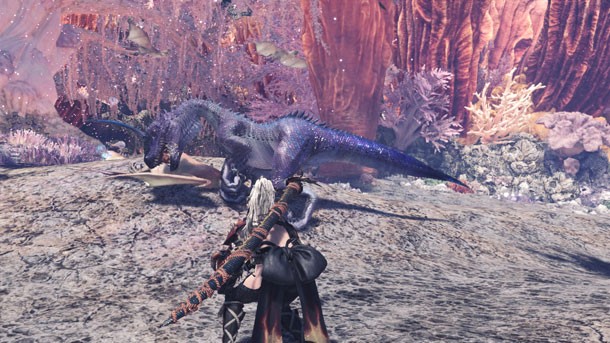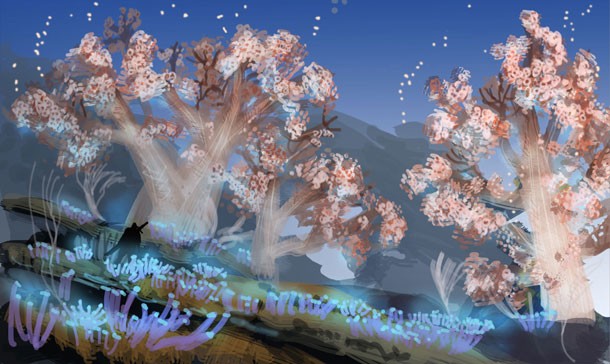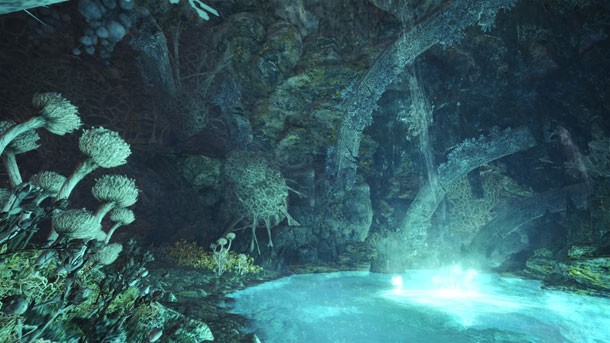Our extra-large special edition is here. Subscribe today and receive the 25% longer issue at no extra cost!
The Lowdown On Monster Hunter: World’s Stunning Coral Highlands Map

Monster Hunter: World’s creatures are the stars of the game, or at least that’s what the early part of the adventure may lead you to believe. The first few maps are familiar, built around biomes such as deserts and forests that are about as grounded as you can get – even though they’re inhabited by bizarre monsters. That changes with the third map, Coral Highlands, which essentially takes some of the most impressive things about undersea life and puts them on dry dock. We talked to the developers about this memorable location during our visit to Capcom’s offices, and came back with some exclusive gameplay footage of it, too.
“The concept was that players will have been through the Ancient Forest and then they’ll have been to the Wildspire Waste, which are relatively realistic stages,” says Kaname Fujioka, Monster Hunter: World’s executive director and art director. “They look like they could take place somewhere on Earth, albeit on a large scale. Once you got used to that and became accustomed to that, we wanted to surprise players – not just in terms of visuals, but also gameplay.”
The map’s gameplay hook is built around verticality, with the edges of the map rising toward a central coral plateau. To navigate these heights, players can climb it old-school style, hitch a ride on a wyvern, or take advantage of the many thermal vents strewn throughout the location. Just because the map features fantastical elements such as wyverns and other monsters, keeping things grounded (within the lore of Monster Hunter, at least) was an important part of the design process.

“I wanted to think about the ecosystem in realistic terms,” Fujioka says. “What is the basis of the ecosystem in this stage? Something has to be the food or the lower-level bases. Taking inspiration from this artwork, coral actually reproduce by spawning eggs, and there are soft corals and there are hard corals. These sakura-style trees blooming are almost like when the cherry blossoms fall in Japan in the spring. They bloom out these eggs, and they’d be forming the basis of life in this stage. That was the idea that really kicked off the Coral Highlands concept.”
These eggs drift down from above, creating a sensation that is indeed like blooming cherry blossoms. It’s a striking effect, and the sense of scale and wonder is amplified by how it’s such a contrast from the earlier stages. The team drew inspiration not only from the undersea world, but also from field research they took in Chile during Monster Hunter 4’s development – work that would later go into MH 4’s Ancestral Plains area. In one national park, they saw a wind-scoured environment that served as inspiration for World.
“Seeing how the winds and the strong currents affected the way that everything lives in this area – even the grasses and plants, they don’t grow very tall, because they wouldn’t be able to withstand the winds, so they grow in little puffy bunches,” Fujioka says. “The way the grass grows affects how the herbivores eat the grass, and that affects how the carnivores eat the herbivores. It all flows out from this baseline concept.”
Fujioka says that this kind of research is key for creating believable worlds, especially for a game like Monster Hunter that features so many varied biomes. “It’s really important for designers to get out and about all over the world, because there are so many types of climates that you can’t experience in Japan,” he says. “You have to get personal hands-on experience with a place in order to really understand it and to put that into your work.”
The team also incorporates subtle environmental storytelling into each map, and sometimes between them. For example, you can see how the water that flows from the Ancient Forest’s rivers and streams feeds the marshes and other wetlands in the Wildspire Waste. If you pay attention, even the condition of the coral in Coral Highlands tells a little story.

“As you traverse upward, you’ll find that it’s a natural setting for the bird-like predator in the stage to have a higher nesting area, but the higher you go in the stage, the corals are decaying,” Fujioka says. “They’re away from their life source, and they’re beginning to crystalize and harden and starting to fade with their color right at the top. The designers also designed lower levels on the stage, and it’s almost like a cave system. That means bioluminescence comes into play with the design of the stages and the creatures. We fleshed it out in both upward and downward directions.”
You may not be able to absorb everything that the Coral Highlands have to offer on your first hunt – particularly since you’re being hunted by its local inhabitants, too – but observant players will be rewarded for paying attention. Even if you don’t geek out too deeply, it’s difficult not to be impressed by the map’s intricate beauty.
We’ll have more information on Monster Hunter: World throughout the month, including deep dives on some of the game’s monsters. Be sure to check our cover hub regularly for more features, videos, and more.

Get the Game Informer Print Edition!
Explore your favorite games in premium print format, delivered to your door.
- 10 issues per year
- Only $4.80 per issue
- Full digital magazine archive access
- Since 1991









